Posted by James (admin) on 14th April 2014
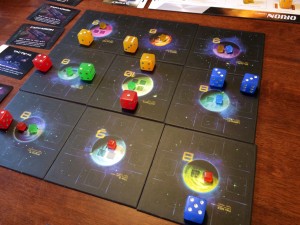
Quantum is a light, space-themed game. Players have ships which are represented by dice that travel between the planets trying to colonise them (place cubes on them). The first player to place all their cubes wins.
The ships (dice) are rolled to determine what type of ship they are – a low number means they are slow moving but powerful in combat, and vice versa. (In fact, the dice value is how many spaces they can move which makes things simple.) Each type of ship has a special power too, such as transporting another ship, swapping places, changing a ship’s value and this makes each quite different.
On their turn, a player can take 3 actions. An action can be used to activate a ship (move/attack), re-roll a ship, bring a ship on from the scrap yard, or carry out research. A player can use 2 actions to place a cube on a planet if they have ships next to the planet that add up to the planet’s number and if there is still room to place a cube there. (A player can also place a cube if they win enough combats.) Read the rest of this entry »
Tags: board game news, Board Games, board gaming, Essen, Funforge, Quantum, Spiel 13, Spiel 2013
Posted in Board Game Review, Board Games, Essen Spiel 13, Quantum, Spiel 2013 | No Comments »
Posted by James (admin) on 11th April 2014
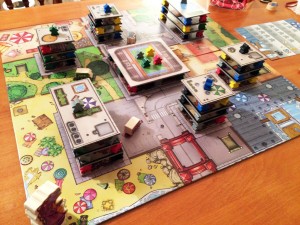 Rampage is a brilliant concept for a dexterity game. It’s like a Godzilla-style movie with tall buildings to destroy and people to eat. The board is divided into several coloured areas called neighbourhoods, and the player with the most Victory Points (VPs) at game end wins.
Rampage is a brilliant concept for a dexterity game. It’s like a Godzilla-style movie with tall buildings to destroy and people to eat. The board is divided into several coloured areas called neighbourhoods, and the player with the most Victory Points (VPs) at game end wins.
Rampage may sound kind of normal so far for a board game but it is anything but that as the gameplay is actually based on physically destroying the city. Each turn, your monster get 2 actions. To move your monster, you flick the feet disc. To attack buildings, take your monster piece and drop it onto a building (if you’re near enough). To use your breathe attack, place your chin on your monster piece and blow. To throw a vehicle, place the vehicle piece on top of your monster and flick it. Monsters can attack anything including each other and a successful attack removes one of their teeth. After their actions, your monster eats meeple out in the open in their current neighbourhood but no more than the number of teeth they have.
Buildings consist of layers of card floors separated by meeple of random colours. You want to knock these buildings down so you can (potentially) eat the meeple but you also take any floor sections which have nothing on them as these are worth VPs too. Read the rest of this entry »
Tags: board game news, Board Games, board gaming, Essen, Rampage, Repos Productions, Spiel 13, Spiel 2013
Posted in Board Game Review, Board Games, Essen Spiel 13, Rampage, Spiel 2013 | No Comments »
Posted by James (admin) on 10th April 2014

Legacy (or Legacy: Testament of Duke de Crecy to give it its full name) is a very innovative game where players try to create the most successful 18th century family starting with a single family member. Each round, players use their actions so that the current generation can get married, have children, buy mansions, start business ventures, arrange marriages for their children, etc. After a fixed number of rounds, the children grow up, any arranged marriages take place, and they become the current generation. Players then use actions for this new generation to get married, have children, etc. After the 3rd generation’s actions, the game ends and the player with the most points (Honour) wins.
Each player has an income track which earns cash each round, and a prestige track which earns Honour each generation. Players also earn Honour for having children, fulfilling objectives on their Patron card, fulfilling missions, as well as from friends marrying into the family, acquiring titles, etc. Plus, players must constantly manage their cash and friends – Friends are cards in a player’s hand each showing their sex, nationality, occupation, benefit when married into your family, and marriage cost (some generate cash as they come with a dowry). Read the rest of this entry »
Tags: board game news, Board Games, board gaming, Essen, Legacy, Portal Publishing, Spiel 13, Spiel 2013
Posted in Board Game Review, Board Games, Essen Spiel 13, Legacy, Spiel 2013 | 4 Comments »
Posted by James (admin) on 9th April 2014
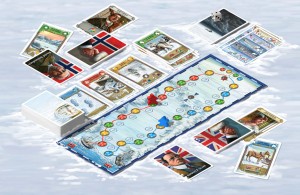 1911 Amundsen vs Scott is a simple, quick-moving, 2-player race to the South Pole which is full of small decisions. The game is based on the real events where Amundsen beat Scott to the Pole and Scott didn’t return.
1911 Amundsen vs Scott is a simple, quick-moving, 2-player race to the South Pole which is full of small decisions. The game is based on the real events where Amundsen beat Scott to the Pole and Scott didn’t return.
Players each have their own path of coloured spaces to move along and the first player to reach the South Pole wins. On their turn, a player draws 1-3 cards and can then play cards. When taking cards, you must draw the right-most (oldest) 1, 2 or 3 cards by discarding 0, 1 or 3 cards from your hand respectively. This can make for some interesting decisions because if you see cards you really want (or ones you don’t to deny your opponent) then you must decide whether it’s worth discarding cards you have to gain the new ones.
Almost all cards show one of 4 colours and many cards show one of the various special actions too (occurring when drawn, played or discarded). To move, you must play cards that match the colours of the next spaces along your path – 1 card for your next space, 2 cards for each space after that. This adds lots of fast card-management decisions to your game as you’re constantly trying to collect the mix of cards that will advance you and hinder your opponent. Many cards are both a colour and a type which adds some extra decisions to work out whether to use a card for its colour or its type (special effect). This is made slightly more tricky because you have a hand limit of 7 cards (and sometimes even fewer), plus the mix of cards you want changes rapidly as you and your opponent move. Read the rest of this entry »
Tags: 1911 Amundsen vs Scott, board game news, Board Games, board gaming, Essen, Spiel 13, Spiel 2013
Posted in 1911 Amundsen vs Scott, Board Game Review, Board Games, Essen Spiel 13, Spiel 2013 | No Comments »
Posted by James (admin) on 7th February 2014
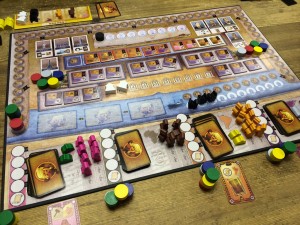 Artifact is a worker placement game with a difference as players place a common set of action markers which are limited in number and the cost of using them varies.
Artifact is a worker placement game with a difference as players place a common set of action markers which are limited in number and the cost of using them varies.
THE GAME
Players are archaeologists digging up artifacts, shipping them home and putting on exhibitions (after all, as Indy taught us, ‘they belong in a museum’). Players primarily score victory points (VPs) at game end by gaining museum exhibition tiles and having cash. The final round is triggered by one of 4 different events such as finishing the 8th round, when one deck of artifact cards runs out, etc.
Actions
During a round, players take turns performing either 1 or 2 actions. If a player passes, they can not perform any more normal actions that round (although they can perform a special action on their turn). All players start each round with 6 wooden action markers and there are 6 different types of these: ships, museums and 4 different colours of workers (one for each continent). The board has a track for each type of action marker and each space on these tracks shows a cost (going from from 5 down 1). Read the rest of this entry »
Tags: Artifact, Bernd Eisenstein, board game news, Board Games, board gaming, Essen, Jeffrey D Allers, Spiel 13, Spiel 2013, White Goblin Games
Posted in Artifact, Board Game Review, Board Games, Essen Spiel 13, Spiel 2013 | No Comments »
Posted by James (admin) on 30th January 2014
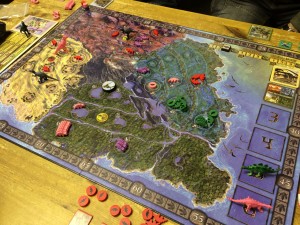 Triassic Terror is a dinosaur-themed, area control game by Peter Hawes – designer of Francis Drake (I will be reviewing this soon), Wars of the Roses and Heads of State.
Triassic Terror is a dinosaur-themed, area control game by Peter Hawes – designer of Francis Drake (I will be reviewing this soon), Wars of the Roses and Heads of State.
THE GAME
During the game, players try to dominate the landscape by growing their dinosaur herds and moving them from area to area. The board is split into 4 different terrains which are each split into 3 areas. There are 3 positions within each area – the largest herd in an area takes the best position, second largest takes the next one, and third largest takes the last one. If there’s a fourth herd in an area, it immediately dies – welcome to the harsh brutality of Triassic Terror.
The game lasts several rounds and Victory Points (VPs) are scored after each era (a group of rounds). VPs are scored based the on position a herd occupies in an area – each area scores slightly differently but the most VPs are always for the better positions (occupied by the biggest herd in the area). One side of the board is for 2-4 players, the other for 5-6 players – the difference being that the numbers of VPs scored are slightly different and all 3 positions in each area score in the 5-6 player game (rather than just the top two). Read the rest of this entry »
Tags: board game news, Board Games, board gaming, Essen, Spiel 13, Spiel 2013, Triassic Terror
Posted in Board Game Review, Board Games, Essen Spiel 13, Spiel 2013, Triassic Terror | No Comments »
Posted by James (admin) on 29th January 2014
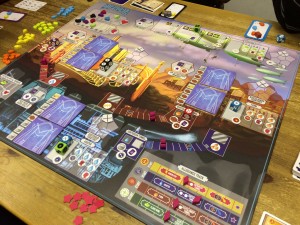 Played: Euphoria Played: Euphoria
After playing Euphoria last week with 5 players, a couple of us wanted to try it with 2 players. The game is mostly the same with just 2 differences: it takes only 2 actions to build a market (not 4 when played with 5 players), and there are only 2 spaces where stars can be placed in each territory (not 5 as with 5 players).
As before, I enjoyed playing Euphoria – the theme works really well with the game mechanics and working out how to use workers and resources is entertaining. It worked fine with 2 players, although I think it’s more fun with more players as there’s more chance of your workers being bounced back to you, more chance of higher totals to earn commodities, and more development of the allegiance tracks and mines which make a big difference.
I think most of the issues could be solved with a few more rules for scaling the game, such as making the tracks shorter. I’ll post more thoughts about this soon.
Euphoria worked well enough with 2 players – I would prefer to play it with more but, with the current rules, I think 3 players would be fine and 4+ would be best.
Played with 2. (To find out more about Euphoria, you can read my main review.) |
|
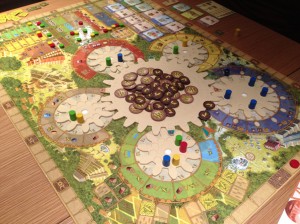 Played: Tzolk’in Played: Tzolk’in
It had been a long time since I last played Tzolk’in and it definitely showed as I tried to recall my previous games so I could create a decent flow of resources to then convert into points.
Tzolk’in is definitely a tricky game to balance which makes it a good challenge. There are several ways to score points and I think you definitely need to choose to pursue just one or two of these in order to do well.
Tzolk’in works well with 2 players. Each 2-player game can be a little different as neutral workers block some of the locations on the wheels (determined by randomly drawn cards at the start of the game). I think the 2-player game may be slightly more forgiving as turn order can be quite brutal with more players because the last player in turn order can find the wheels packed with workers – whilst that means they could place their workers further around a wheel, it requires lots of corn.
Played with 2. (For more details on Tzolk’in, you can read my full review.) |
|
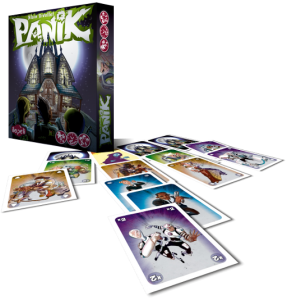 Played: Panik Played: Panik
Panik is a very quick, light game with some bluffing. Players place their ghost hunters in front of mansions in order to score points equal to the mansion’s value; however, each player only knows what a few of the mansions are worth (and each player knows about different mansions). Placing a ghost hunter can expel one already placed there to a different mansion (chosen by the expelled card’s owner) so there’s some jostling during the game. Various ghost hunters have special effects too.
With limited information on which to base to your decisions, the fun is from trying to read into what your opponent(s) have done. However, that also means you need to work out if they’re trying to mislead you, and work out how you can mislead them too.
Panik worked quite well with 2 players (taking only 5-10 minutes for a game); however, I think it’s better with more. The mind games and displacing other ghost hunters mean there’s more to it than it first appears, but there may not be too much more to discover after some replay. Can work as a gamers’ filler game, but more for a lighter audience.
Played with 2 and 4. |
James.
Tags: board game news, Board Games, board gaming, Essen, Euphoria, Panik, Spiel 13, Spiel 2013, Tzolk'in
Posted in Board Games, Euphoria, Panik, Played, Tzolk'in | 3 Comments »
Posted by James (admin) on 25th January 2014
As writing full reviews takes some time and I often play more games than I have time to review. As a result, there are many games that I play that don’t get reviewed for while, if at all. Therefore, this is the first of a new type of post where I will post a few quick thoughts about the games I have played. If there’s a game I mention that you’d specifically like a full review of, add a comment to let me know.
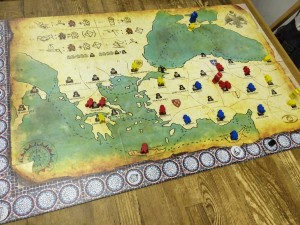 Played: Byzantio Played: Byzantio
Byzantio is an area control game with a difference as each player only has a specific number of each of the different actions to use during the whole game so you need to ration them carefully. Players select their own objective cities.
I enjoyed this game, although it felt lighter because there was a bit more randomness than I expected, with the dice deciding several of the action types adding most of that. I don’t mind some randomness in a game, so it’ll be good to have that in mind when playing it again, and I hope it’s not too big a factor for my preferences. There are a few things I’d do to add more clarity to the board, but these are polish rather than fundamental.
Still, working out how to use your actions and how to try and disguise your intentions added some good gameplay.
Played with 3. |
|
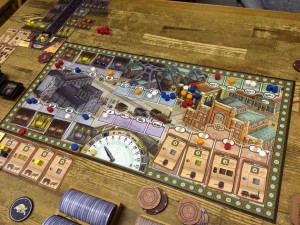 Played: Coal Baron Played: Coal Baron
Coal Baron is by the great team of Kramer and Kiesling (also called Glück Auf) which I previewed before Spiel in Essen. This in an excellent eurogame – plenty of elements to balance but plays in a short time too.
It felt like a lean and well-oiled game design made up of only the most necessary and important elements. There’s nothing revolutionary in the game design (although there is a nice small twist added to worker placement), but it impressed me with it’s elegance and how it delivered a tense, thoughtful game from such simple game mechanics.
Light enough for newer players, and enough decisions for experienced gamers wanting a short game. Very impressed.
Played with 4. |
James.
Tags: board game news, Board Games, board gaming, Byzantio, Coal Baron, Eggertspiele, Essen, Glück Auf, Ludicreations, Michael Kiesling, Spiel 13, Spiel 2013, Wolfgang Kramer
Posted in Board Games, Byzantio, Essen Spiel 13, Glück Auf, Played, Spiel 2013 | No Comments »
Posted by James (admin) on 20th January 2014
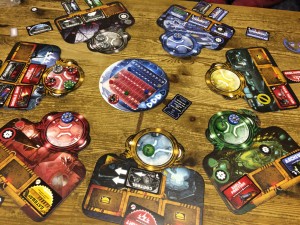
Theseus is a sci-fi game set on a space station where the different factions (soldiers, scientists, aliens and greys) are trying to take control. The setting and photos may give the impression it’s a complicated game, but it’s actually a eurogame that is relatively quick and contains some good tactical play.
THE GAME
Players take turns moving their units around different locations (sectors) on the space station. Each sector is a separate board piece and these are arranged in a circle: one sector for each player’s faction, plus one each for the Corridors, Control Room and Tech Bay. Each sector has 4 rooms (in the circular area) as well as several spaces for action cards (the oblong areas) which players will place during the game. Each player has their own unique deck of action cards. These first enter the game by being placed next to sectors (called ‘pending’ cards) which may get to be placed (‘installed’) on a sector later.
On their turn, a player must move one of their 3 units a number of sectors clockwise equal to the number of units currently on the unit’s starting sector, i.e. if there are 2 units on a sector, then a unit moved from there moves 2 sectors clockwise. A moved unit is placed in one of the 4 rooms (arranged in a 2 x 2 grid) on the sector they move to. Some rooms have walls between them which block combat. If all 4 rooms are full, the arriving player ejects one of the units there into space and takes their position. If a unit’s move means all the rooms in the sector are now full, all units belonging to the player whose turn it is attack other units in that sector. (Only soldiers start with combat ability; whereas, other factions’ units need upgrading first.) Read the rest of this entry »
Tags: board game news, Board Games, board gaming, Essen, Portal Publishing, Spiel 13, Spiel 2013, Theseus
Posted in Board Game Review, Board Games, Essen Spiel 13, Spiel 2013, Theseus | 1 Comment »
Posted by James (admin) on 18th December 2013
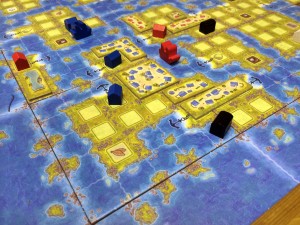 Amerigo is a game by Stefan Feld – a designer who has created some great game such as Bora Bora, Rialto, Trajan, Strasbourg, Die Speicherstadt to name just some that I’ve reviewed.
Amerigo is a game by Stefan Feld – a designer who has created some great game such as Bora Bora, Rialto, Trajan, Strasbourg, Die Speicherstadt to name just some that I’ve reviewed.
THE GAME
Like two other Queen Games (Shogun and Wallenstein), Amerigo uses a cube tower – a card tower with couple of card sections inside (like floors in a building) which have various holes in them. When cubes are dropped into the tower, some come out at the bottom and some are retained inside the tower on the card layers (which may fall out when more cubes are dropped into the tower later).
Made up of multiple tile sections, the board show grids of land and water spaces and, together, form islands. During the game, players explore and colonise islands by moving their ships, setting up trading posts and building villages. Players score Victory Points (VPs) for building villages, gathering goods (and increasing the value of their goods), developments, etc. The game lasts 5 rounds (each divided into 7 phases) and the player with most VPs at the end of the game wins.
So far, it sounds fairly standard but the core game mechanic – the action system – driving Amerigo is nicely different. There are 7 different actions that a player can take and each corresponds to a specific colour of cubes: Sail and place trading posts (Blue), Gain cannon (Black), Buy building tiles (Red), Development (Brown), Place building tiles (Green), Improve trade good values (Yellow), and Special (White). Read the rest of this entry »
Tags: Amerigo, board game news, Board Games, board gaming, Essen, Spiel 13, Spiel 2013, Stefan Feld
Posted in Amerigo, Board Game Review, Board Games, Essen Spiel 13, Spiel 2013 | 2 Comments »







 Triassic Terror is a dinosaur-themed, area control game by Peter Hawes – designer of Francis Drake (I will be reviewing this soon), Wars of the Roses and Heads of State.
Triassic Terror is a dinosaur-themed, area control game by Peter Hawes – designer of Francis Drake (I will be reviewing this soon), Wars of the Roses and Heads of State.



 Played: Coal Baron
Played: Coal Baron
